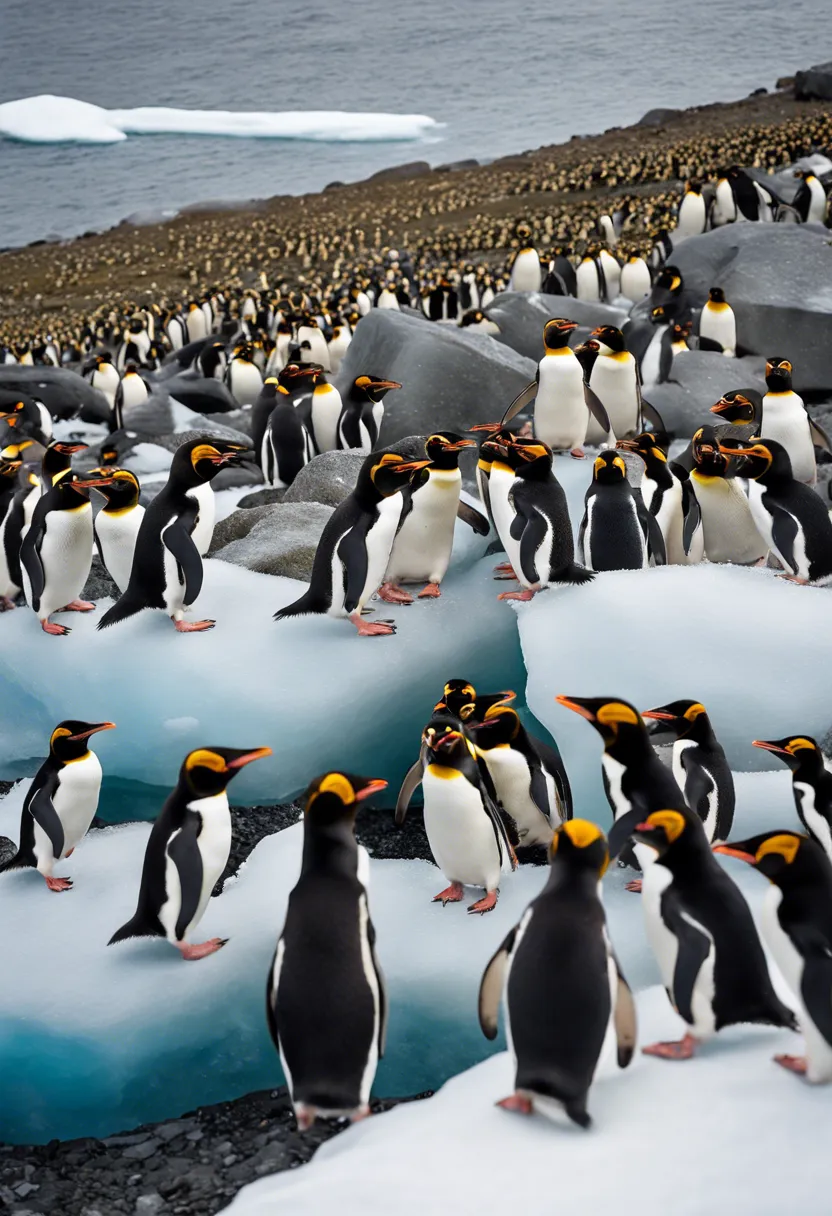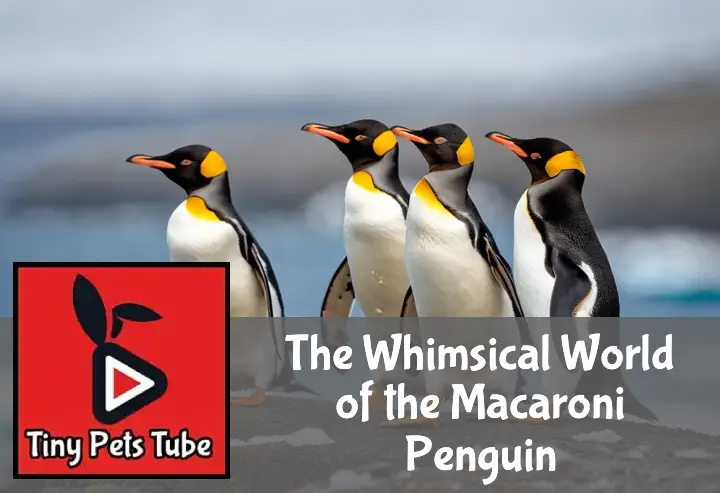Ever stumbled upon a creature so oddly named that it made you chuckle? Meet the Macaroni Penguin, folks! This delightful bird, with a name straight out of a pasta dish, is as intriguing as its moniker suggests.
In this whimsical world of the Macaroni Penguin, we’ll dive beak-first into their fascinating lives. From their peculiar physical traits to their distinctive social behaviors – it’s all here! So buckle up and keep reading about The Whimsical World of the Macaroni Penguin.
Key Takeaways
- Macaroni Penguins are one of the most numerous species of penguins.
- They are named after an 18th-century term for a fashionable person, due to their distinctive yellow crest.
- These penguins breed in large colonies on sub-Antarctic islands and spend winter at sea.
- Their diet mainly consists of small fish, squid, and krill.
- Climate change and overfishing pose significant threats to their population.

What is a Macaroni Penguin?
Well, let’s dive right into the world of macaroni penguins. These fellas are one of the most distinctive members of the penguin species, and they’ve got some pretty interesting quirks that set them apart in the bustling crowd of Antarctic wildlife.
Origin of the Name
So, you’re probably wondering why it’s called a macaroni penguin, right? It’s not because they have an affinity for pasta, I’ll tell you that much! The name actually comes from an old English term for flashy dressers. Back in the day, anyone who was decked out in extravagant attire was dubbed “macaroni.” And with their flamboyant yellow crests, these penguins are certainly dressed to impress!
Now, isn’t that a fun bit of etymology of macaroni? Who knew bird names could be so tied up with fashion trends?
Physical Characteristics
When it comes to looks, macaroni penguins aren’t your average birds. They’re part of the group known as crested penguins, and boy do they live up to that name! Their most striking feature is their bright yellow crest feathers which arch over their eyes like some kind of natural sunglasses.
Apart from their fancy headgear, these guys also sport a black face and upperparts contrasted by white underparts. And let’s not forget about their orangey-pink feet – talk about stylish! So if you’re ever trying to identify Antarctic birds, keep an eye out for these dapper dudes.
Habitat and Distribution
As for where these fashionable birds hang out, well, they prefer cooler climates. You’ll find most macaroni penguins chilling (literally) in the sub-Antarctic region and on various islands within the Antarctic Convergence.
However, life isn’t always a beach party for these guys. Their habitats are under threat due to climate change and overfishing, which is messing with their food supply. So while they might be one of the most widespread penguin species, their numbers are sadly dwindling. But hey, let’s keep our flippers crossed for these unique birds, shall we?
How Does the Macaroni Penguin Behave?
Well, let’s dive in to explore the fascinating world of macaroni penguin behavior. These critters are quite the social butterflies, or should I say, social penguins?
Social Behavior
First off, macaroni penguin colonies are like bustling cities. They live in large groups with thousands of their kin. It’s a bit like a massive family reunion that never ends! This communal living pattern helps them survive and thrive.
But it ain’t all chaos and cacophony. There’s order to this madness! Some sort of social hierarchies in penguins exist, though it’s not as cutthroat as human corporate ladders. More like a friendly neighborhood watch where everyone looks out for each other.
And speaking of looking out for each other, these birds exhibit some pretty cool cooperative behaviors. From group huddles to keep warm to taking turns diving for food, it’s all about teamwork in the world of macaroni penguins.
Communication Methods
Now onto how they chat with each other. Yes, you heard right! Penguins do talk…in their own way. The language of macaroni penguin communication involves a mix of vocalizations and physical gestures.
Their squawks and calls are not just noise but meaningful conversations. Each sound carries specific messages – from warnings about predators to flirtatious advances during mating season.
Physical gestures also play a key role in their communication playbook. A flipper wave here or a head bob there can signal everything from aggression to submission. These methods are vital for their survival and breeding – it’s all about saying the right thing at the right time!
Mating and Breeding Habits
Finally, let’s talk about love…penguin style! The mating rituals and breeding cycle of macaroni penguins are quite the spectacle. It starts with a courtship dance that would put any ballroom dancer to shame.
Once a pair hits it off, they get down to some serious nest building. Using pebbles and grass, these lovebirds create cozy nests to welcome their future chicks.
And when it comes to parenting, both mom and dad share the responsibilities. From incubating the eggs to feeding the chicks, parental roles in animals like macaroni penguins are pretty evenly split. Now that’s what I call progressive parenting!

What are the Survival Strategies of the Macaroni Penguin?

When it comes to survival, the Macaroni Penguin is no slouch. These little fellas have developed some pretty nifty strategies to keep them ticking in their harsh Antarctic homes.
Hunting and Feeding Habits
First off, let’s talk grub. The Macaroni Penguin diet mainly consists of small shrimp-like critters called krill. They’ve got this cool technique where they dive deep into the ocean, using their keen eyesight to spot these tasty morsels.
But wait, there’s more! Not only do they dive solo, but they also engage in cooperative feeding behavior. It’s like a synchronized swimming routine, but with a delicious seafood buffet at the end!
Predators and Threats
Now onto the not-so-fun part – predators. The main penguin predators in Antarctica include seals and sea birds. But it’s not just nature they have to worry about; human activities pose a significant threat too.
Climate change is messing with their food sources and habitat, making life tougher for our feathered friends. Conservation efforts are underway to protect the Macaroni Penguin, but it’s an uphill battle against these growing threats.
Adaptations for Survival
So how does this quirky bird survive? Well, they’ve got some neat tricks up their flippers! Their bodies are designed for the cold – think waterproof feathers for insulation and a layer of blubber for warmth.
Their behavioral adaptations are equally impressive. They’re social creatures that huddle together for warmth and protection from predators. Plus, their swimming agility is top-notch – perfect for evading those pesky seals!
What is the Conservation Status of the Macaroni Penguin?
Let’s dive into the world of Macaroni Penguin conservation. These quirky birds are facing some real challenges, but there’s also a lot of love and effort going into keeping them around.
Current Population Trends
When it comes to Macaroni Penguin numbers, things aren’t looking too rosy. We’ve seen a worrying decline in their population over recent years. But what’s causing this? Well, it’s a mix of factors.
First off, breeding success rates have taken a hit. It seems like our feathered friends are having trouble raising their chicks successfully. This could be due to changes in their environment or lack of food resources.
Then there’s the impact on their habitat. With climate change and human activities reshaping the Antarctic landscape, these penguins’ homes are under threat.
Threats to Their Existence
So what exactly is threatening our Macaroni Penguins? Well, climate change is a biggie. Rising temperatures and melting ice caps are messing with their natural habitats.
Then we’ve got invasive species predation – you know, those pesky seals and birds that have moved in and started munching on penguin eggs and chicks. Not cool!
And let’s not forget about us humans. Our fishing industry can sometimes accidentally catch these penguins or deplete their food sources.
Conservation Efforts
But it’s not all doom and gloom for our Macaroni Penguins! There are some fantastic wildlife conservation programs working hard to protect them.
For instance, we’ve got protected marine areas set up specifically for these penguins. These safe havens give them space to breed without disturbance from humans or predators.
International wildlife treaties also play an important role in protecting these birds from threats like overfishing or habitat destruction.
And lastly, ongoing research on Macaroni Penguins is helping us understand more about their needs and how we can help them thrive. So, while they’re facing some tough challenges, there’s a lot of hope for these funky birds!

To Wrap Up
In the grand circus of nature, the Macaroni Penguin is the clown with a top hat, always ready to put on a show. We’ve dived into their quirky world, from their flamboyant crests to their epic migration journeys.
Remember, these waddling wonders aren’t just for our amusement; they’re an essential cog in our ecosystem’s wheel. Let’s ensure their survival isn’t left hanging like spaghetti on a fork!


